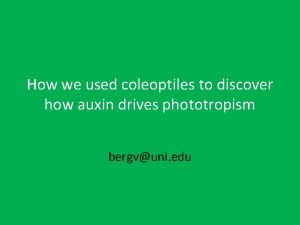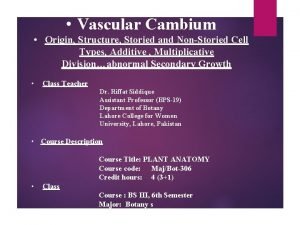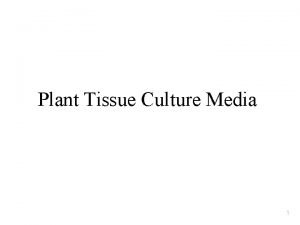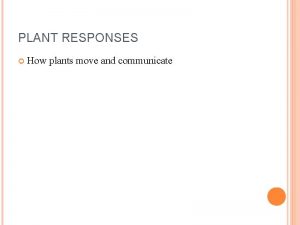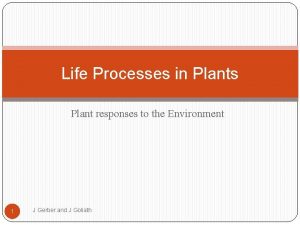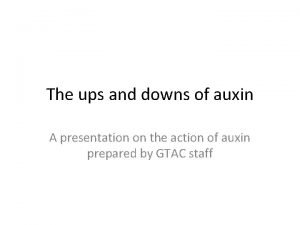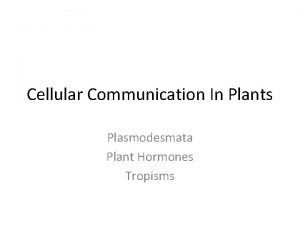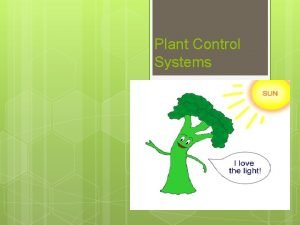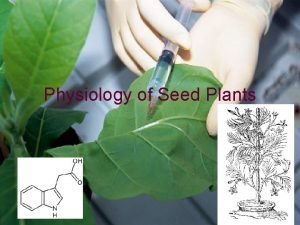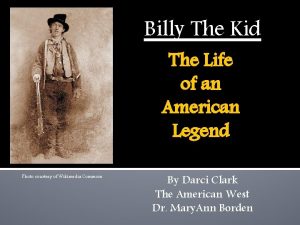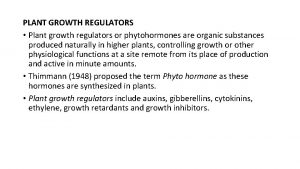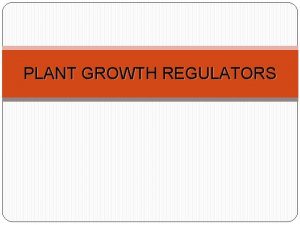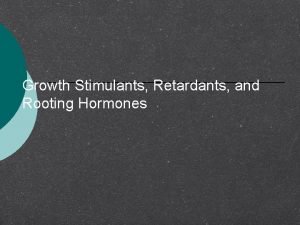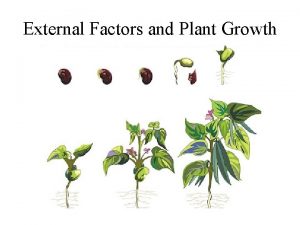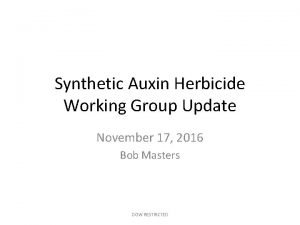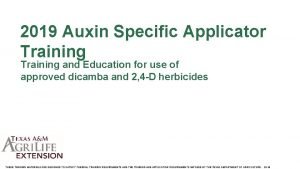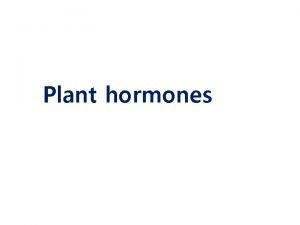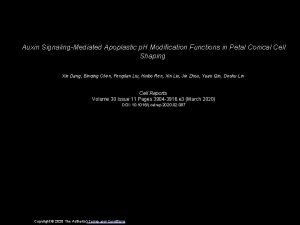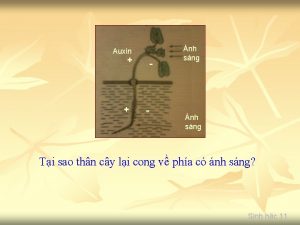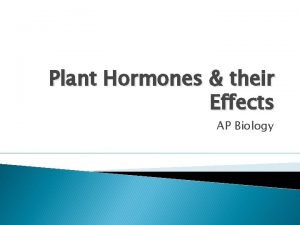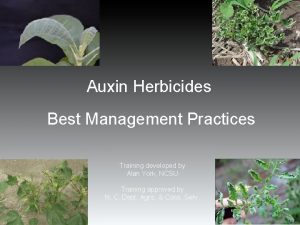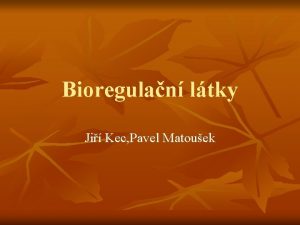Growth Regulators Growth Regulators Two primary groupings auxin






















- Slides: 22

Growth Regulators

Growth Regulators • Two primary groupings - auxin mimics and auxin transport disruptors • Mimics – phenoxys, picolinic acids, benzoic acids, pyrimidine carboxylic acid • Transport disruptors - quinclorac, naptalam, and diflufenzopyr

History • Simultaneous discoveries by plant physiologists in U. S. in 1942 • Trying to study ways to increase crop yield through hormone manipulation • After World War II, several companies began manufacture and marketing – Du. Pont, Dow, Monsanto, Union Carbide • Beginning of herbicides and weed science as a discipline

Formulations of 2, 4 -D • 28 different formulations since discovery – Ester formulations have greater activity than salts – Short chain esters highly prone to volatilization and no longer registered • Currently 9 supported by EPA – parent acid – sodium, diethanolamine, dimethylamine, isopropylamine, and tri-isopropanolamine salts – 2 -butoxyethyl, 2 -ethylhexyl, and isopropyl esters • Dicamba only a salt, picolinic acids both salts and esters

The monocot vs. dicot issue? ? • For many years phenoxys were thought to be active on dicots and not monocots – Labeled for use in grass crops such as wheat, corn, sorghum, rice, pastures • Active only on broadleaves, which were mostly dicots • Separation still exists today – Broadleaves vs. grasses, or even weeds vs. grasses

The 2, 4, 5 -T Story • 2, 4, 5 -T developed in late 1950’s, early 60’s • Tremendous soil and foliar activity, considered the standard for woody brush control (Silvex) • Also principle active in Agent Orange • Agent Orange used for wide-spread jungle defoliation in Vietnam war • Actually combination of 2, 4 -D and 2, 4, 5 -T • High levels of dioxin as a contaminant in Agent Orange • EPA cancelled registration in early 1980’s

Mode of Action • Foliar and root uptake, extensive translocation in phloem to meristems (weak acids) • Rapid twisting, stem elongation, leaf malformation that includes cupping, strapping, curling • Floral abortion, mis-shapenned fruit, puckering • Stem bending in grasses, brace root malformation • Eventual meristem necrosis followed by plant death

Symptomology

Mechanism of Action - Mimics • Perceived by plant as auxin? • Activate membrane –bound ATPase pump, acidified cell walls and caused elongation • Increase in RNA polymerase – increased cell division at uncontrolled rate • Increased ethylene generation

Mechanism of Action - Mimics • Appears to be linked to influx and efflux carrier proteins in the plasma membrane • 2, 4 -D is readily taken up by influx carriers • Not exported by efflux carriers • More importantly, 2, 4 -D is not metabolized nor diffused to a great extent • Stimulation of ethylene also observed

Quinclorac • Although auxin mimic, appears to cause effects through ethylene • Stimulates 1 -aminocyclopropane-1 carboxylic acid synthase • S-adenosylmethionine converted to 1 -aminocyclopropane-1 -carboxylic acid ethylene but also hydrogen cyanide • Ethylene stimulates ABA, inducing stomatal closure, photosynthesis ceases, increase in oxidative stress

Mechanism of Action - Transport • Naptalam and diflufenzopyr have been shown and used to inhibit efflux carriers, preventing normal auxin distribution in plant tissues • Diflufenzopyr is used in conjunction with dicamba (auxin mimic)

Time for Thoughts……. . So is the complete story of how these herbicides work ? ?

Selectivity • Almost exclusively metabolism for phenoxys and dicamba – Decarboxylation, dechlorination – Conjugation through glucose or amino acids • 2, 4 -DB and MCPB – tolerance to legumes – β-oxidation of two carbon sequences from the side chain leads to formation of 2, 4 -D, which is the active form – Low β-oxidase activity in legumes, some research suggests lengthening of side chain as another tolerance mechanism activation 2, 4 -DB 2, 4 -D

Selectivity • Picolinic acids – mostly conjugated with sugars and many are sequestered in vacuole • This can result in persistence, carryover and off target movement • First noticed with picloram in tobacco and a mule

Resistance • Relatively rare but has occurred in wild mustard, yellow starthistle, common chickweed • Not fully understood, but appears to be altered receptor

Photo: W. Vencill – Univ. of Georgia 2, 4 -D resistant cotton 2, 4 -D sensitive cotton

Dicamba resistant soybean and cotton • dicamba mono-oxygenase (DMO) cloned from a soil bacterium (Stenotrophomonas maltophilla) • DMO enzyme encodes a Rieske nonheme monooxygenase • metabolizes dicamba to 3, 6 -dichlorosalicylic acid (DCSA) • dicamba O-demethylase complex (monooxygenase, reductase, ferredoxin) • expressed in cell nucleus & chloroplasts where the monooxygenase would have a source of electrons

Fig. 1. Dicamba inactivation. M R Behrens et al. Science 2007; 316: 1185 -1188

2, 4 -D Tolerant Cotton and Soybeans • aryloxyalkanoate dioxygenase provides resistance to certain auxins • gene was isolated from Delftia acidovorans (trait, DHT 2) • codes for a 2 -ketoglutarate dependent dioxygenase that inactivates phenoxyacetate auxins • second gene (aad-1) isolated from Sphingomonas herbicideovarans • inactivates auxins and ACCase-inhibiting herbicides

Wright T R et al. PNAS 2010; 107: 20240 -20245

Mechanisms are quite different • DMO only provides resistance to dicamba • AAD-12 – resistance to anything with a O-C-COOH group on the end. • These technologies will be stacked with other technologies. – Roundup Ready + Liberty Link + 2 or 3 Bt’s…
 Visual elements - light and color
Visual elements - light and color Solidarity meaning
Solidarity meaning Mica plate auxin
Mica plate auxin Xylem parenchyma
Xylem parenchyma Auxin in tissue culture
Auxin in tissue culture Gravitropism auxin
Gravitropism auxin Functions of auxin
Functions of auxin Response to gravity
Response to gravity Auxin effects
Auxin effects 4 tropisms
4 tropisms Auxin transport
Auxin transport Auxin hormone
Auxin hormone Ground tissue
Ground tissue Primary growth and secondary growth in plants
Primary growth and secondary growth in plants Chapter 35 plant structure growth and development
Chapter 35 plant structure growth and development Regulators apush
Regulators apush William roberts billy the kid
William roberts billy the kid North american gaming regulators association
North american gaming regulators association Ac voltage controller and cycloconverter
Ac voltage controller and cycloconverter Silence nonverbal communication
Silence nonverbal communication Voltage regulators keep a constant
Voltage regulators keep a constant Prandial glucose regulators
Prandial glucose regulators Define growth analysis
Define growth analysis


